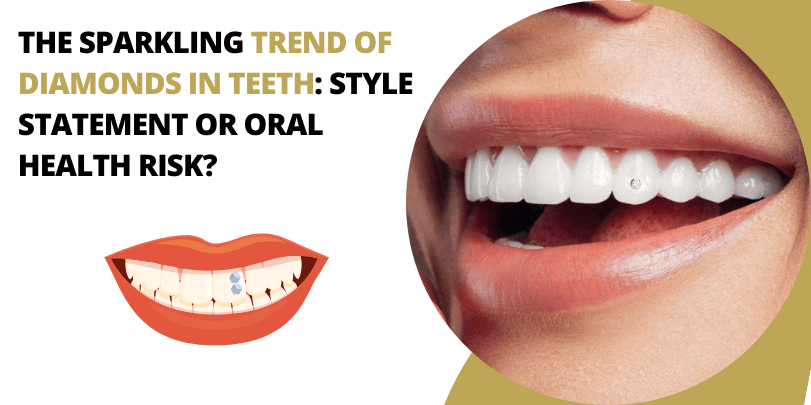In recent years, tooth gems, particularly diamonds in teeth, have emerged as a bold trend in dental fashion.
Celebrities like Hailey Bieber, Katy Perry, and rapper Post Malone have popularized tooth gems, flaunting them at red carpet events and on social media, thereby turning it into a global trend.
While tooth gems may seem like a fun and glamorous way to personalize your smile, they come with their own set of considerations, especially when it comes to oral health.
This blog details everything you need to know about tooth gems, including their history, application process, types, safety tips, oral hygiene practices, and much more.
Whether you’re curious about the trend or considering getting a tooth gem yourself, here’s a guide to help you make an informed decision.
Table of Contents
- What Are Tooth Gems?
- How Are Tooth Gems Applied?
- Types of Tooth Gems
- Are Tooth Gems Safe?
- Maintaining Oral Hygiene with Tooth Gems
- Conclusion
- FAQs About Tooth Gems
What Are Tooth Gems?
Tooth gems involve attaching small decorative jewels such as diamonds, crystals, or other precious stones to the surface of your teeth. Unlike grills, which cover multiple teeth, tooth gems are smaller and more subtle, and serve to add a unique sparkle to your smile.
This trend has roots in ancient Mayan culture, where people adorned their teeth with jade and turquoise to signify wealth and beauty. Today, modern dentistry has refined the practice into a non-invasive cosmetic procedure.
How Are Tooth Gems Applied?
The application process for tooth gems is straightforward, quick, and painless. Here’s what typically happens during the procedure:
Consultation
A dentist or trained professional examines your teeth to ensure they’re healthy enough for the procedure. They may advise against the procedure if you have weak enamel, gum disease, or tooth decay.
Preparation
The tooth where the gem will be placed is thoroughly cleaned to remove any plaque or debris. This ensures the adhesive bonds properly.
Bonding
A special dental adhesive is applied to the surface of the tooth, and the gem is carefully placed on top.
Curing
A curing light is used to harden the adhesive and secure the gem in place. This process usually takes less than 15 minutes.
The entire procedure is non-invasive, meaning no drilling or permanent alteration to the tooth is required.
ICYMI-: Tooth Piercing: The Trendy Way to Add Sparkle to Your Smile
Types of Tooth Gems
There are several options when it comes to choosing a tooth gem:
Crystals – Affordable and available in various colors. Swarovski crystals are a popular choice for a fun, casual look.
Diamonds – Real diamonds are the go-to for those looking to make a luxurious statement.
Gold Shapes – Small gold designs, such as hearts, stars, or initials, are another trendy option.
Custom Designs – Some people opt for unique combinations of gems or even tiny artistic patterns.
Are Tooth Gems Safe?
When applied by a professional, tooth gems are generally safe. However, there are potential risks to be aware of:
Enamel Damage
While the application process doesn’t involve drilling, improper placement or removal can harm your enamel.
Increased Risk of Cavities
Gems can trap food particles and plaque, making it harder to clean your teeth properly. This can lead to cavities if oral hygiene isn’t maintained.
Gum Irritation
If the gem is placed too close to the gumline, it may cause irritation or inflammation.
Maintaining Oral Hygiene with Tooth Gems
Good oral hygiene is crucial to keeping your smile healthy and your gem sparkling. Here are some tips:
- Brush and floss regularly to remove any food particles or plaque that may accumulate around the gem.
- Use an antibacterial mouthwash to prevent bacterial buildup and maintain overall oral health.
- Visit your dentist for regular check-ups to ensure the gem is securely attached and your teeth remain healthy.
Conclusion
Tooth gems combine style and self-expression with dental aesthetics, making them a unique fashion statement. However, their safety and longevity depend on proper application and maintenance. If you’re considering getting a tooth gem, consult with a qualified dental professional to minimize risks and enjoy a safe, sparkling smile.
FAQs About Tooth Gems
1. How long do tooth gems last?
Tooth gems can last anywhere from 6 months to a few years, depending on the type of gem and how well you care for them.
2. Can I remove a tooth gem myself?
It is not recommended to remove a tooth gem yourself, as improper removal can damage your enamel. Always consult a dentist for safe removal.
3. Are tooth gems permanent?
No, tooth gems are not permanent. They are bonded to the surface of your tooth and can be removed or may naturally detach over time.
4. Do tooth gems affect eating or speaking?
In most cases, tooth gems do not affect eating or speaking. However, it’s important to avoid chewing hard foods directly on the gem to prevent it from coming loose.
5. Should You Get a Tooth Gem?
Tooth gems are a personal choice. If you enjoy self-expression and want to add sparkle to your smile, they can be a fun option. Ensure you’re informed about the risks and consult a dental professional for advice.
 Australia No
Australia No Canada No
Canada No India Toll Free No
India Toll Free No UK No
UK No USA No
USA No












